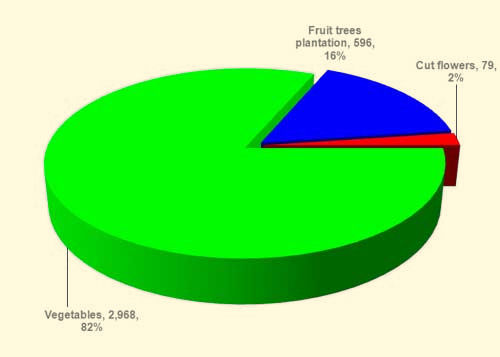|
The R&D activity in the Arava Valley was
initiated in 1986 in the framework of Negev-Arava
R&D, aiming to serve the developmental needs
of the new settlements as they were
officially declared high priority regions
along the Israeli borders.
This activity was supported by the Jewish
Agency for 11 years until 1997, when the
Jewish National Fund (JNF) accepted the
major funding responsibility with
supplement contributions from the Ministry
of Agriculture and Rural Development, The
Ministry for Development of the Negev and
the Galilee, Vice Prime Minister Office, The
Settlement Department of the Jewish Agency,
The regional municipalities (Central Arava,
Tamar), The Plants Council, JCA, and private
sponsors.
|
|
|
The R&D Structure
and Organization
The Arava R&D
activity is governed by a
directory comprised by
representatives of JNF, Central
Arava and Tamar regional
councils, Agriculture Research
Organization (ARO), Agricultural
Extension Service (SHAHAM),
Plants Council, chairpersons of
agricultural committees and
sector coordinators. The role of
this directory is to define the
main objectives and the annual
budget for the R&D activities.
The current
activity is governed by an
Administrative R&D Director,
together with a Scientific
Director nominated by the ARO,
whose aim is to initiate, manage
and promote research in the
organization and to encourage
researchers and other
institutions to carry out
research and collaborate on
programs to support the regional
agriculture and farmers.
The R&D includes
seven sector centers:
vegetables, ornamentals,
plant-protection, orchards,
organic agriculture, fishery,
and produce quality. Each sector
coordinator acts as the
chairperson for the committee
which is comprised of farmers,
extension service staff, and
researchers, who assemble to
determine a priority scale for
the major issues that will be
encountered and solved.
The activities
are carried out in experimental
stations and farmers sites. The
emerging knowledge is
transferred to the farmers
through everyday advisory,
end-season meetings, internet
newsletters and fliers. In
addition, there are occasional
open-days, lectures, and trips
on various topics. |
|
|
|
Central- and
Northern-Arava Valley – General
Information
The Arava region is located
along 180 km from the Dead Sea
in the north to the city of
Eilat on the Red Sea coast, in
the south. The width of the
region varies between 3 to 10 km
from the mountains of the Negev
highlands in the west and the
Edom Mountains of the Jordan
Kingdom, in the east.
The R&D activity takes place in
3 agricultural villages (moshav)
of Sodom Valley - Tamar Council
(Neot-HaKikar, Ein-Tamar, and
Ein-Hazeva (pvt farm)), and in
five agricultural villages
(Idan, Hazeva, Ein-Yahav,
Zofar, and Paran) and two
communal villages (Sapir Center
and Zukim) of Central Arava
Council. The regional public
activities and services are
located in Sapir Center and Yair
Experimental Station
The population of the
Central-Arava region is
comprised of approximately (May
2013) 700 families (of which 530
are farmers), about 3,360
people, and that of the Sodom
Valley (Tamar) 120 families (110
farmers) about 550 people.
The arable land comprised
(2012/13 season) of 35,760 dunam
(9,000 acres, 3,643 hectares),
of which 82% vegetables, 16%
fruit trees plantation (mainly
dates) and 2% cut flowers. The
pepper (Capsicum) is the
major crop in the region and
holds 50% of the total arable
land and 66% of the vegetables
area. The bio-organic farming
holds about 10% of the growing
area
The Arava region produces about 60% of the total Israeli export of
fresh vegetables and about 10%
of the cut flowers export. |
|
| |
|
Central and Northern
Arava - Growing Areas 2012/13
season (Ha, %) |
|
 |
| |
| |
(Vegetables crops growing methods 2012/13
growing season (Ha |